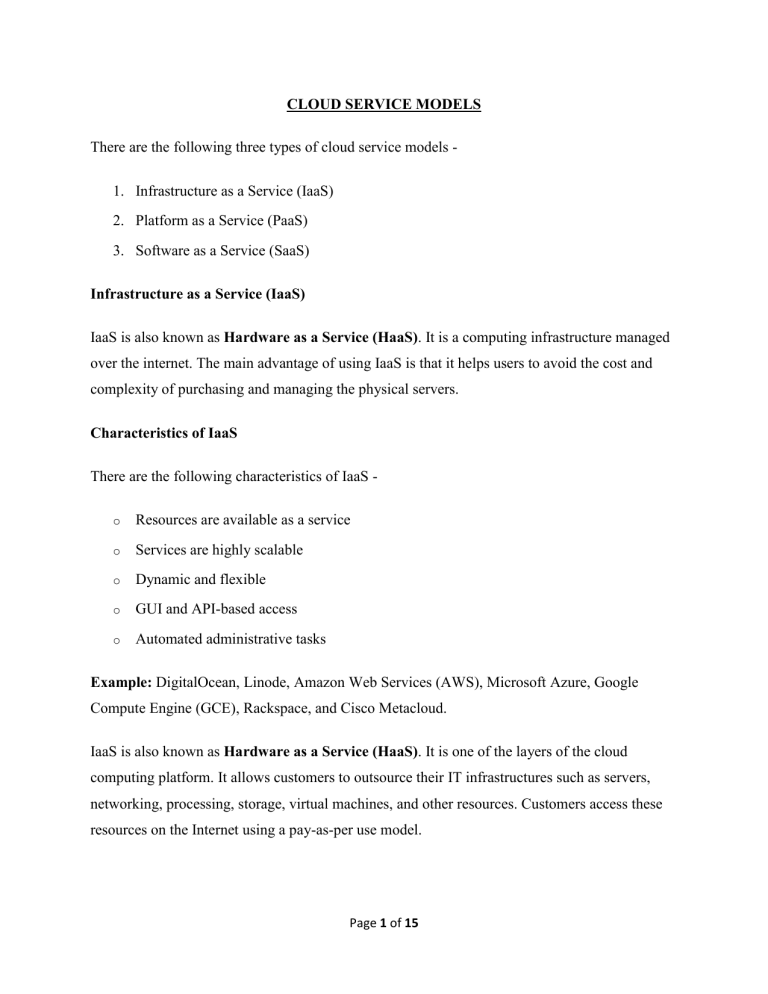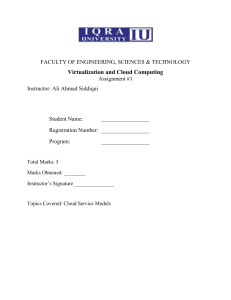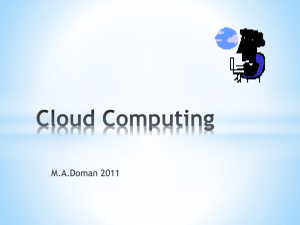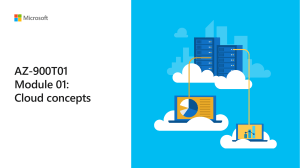
CLOUD SERVICE MODELS There are the following three types of cloud service models 1. Infrastructure as a Service (IaaS) 2. Platform as a Service (PaaS) 3. Software as a Service (SaaS) Infrastructure as a Service (IaaS) IaaS is also known as Hardware as a Service (HaaS). It is a computing infrastructure managed over the internet. The main advantage of using IaaS is that it helps users to avoid the cost and complexity of purchasing and managing the physical servers. Characteristics of IaaS There are the following characteristics of IaaS o Resources are available as a service o Services are highly scalable o Dynamic and flexible o GUI and API-based access o Automated administrative tasks Example: DigitalOcean, Linode, Amazon Web Services (AWS), Microsoft Azure, Google Compute Engine (GCE), Rackspace, and Cisco Metacloud. IaaS is also known as Hardware as a Service (HaaS). It is one of the layers of the cloud computing platform. It allows customers to outsource their IT infrastructures such as servers, networking, processing, storage, virtual machines, and other resources. Customers access these resources on the Internet using a pay-as-per use model. Page 1 of 15 In traditional hosting services, IT infrastructure was rented out for a specific period of time, with pre-determined hardware configuration. The client paid for the configuration and time, regardless of the actual use. With the help of the IaaS cloud computing platform layer, clients can dynamically scale the configuration to meet changing requirements and are billed only for the services actually used. IaaS cloud computing platform layer eliminates the need for every organization to maintain the IT infrastructure. IaaS is offered in three models: public, private, and hybrid cloud. The private cloud implies that the infrastructure resides at the customer-premise. In the case of public cloud, it is located at the cloud computing platform vendor's data center, and the hybrid cloud is a combination of the two in which the customer selects the best of both public cloud and private cloud. IaaS provider provides the following services 1. Compute: Computing as a Service includes virtual central processing units and virtual main memory for the Vms that is provisioned to the end- users. 2. Storage: IaaS provider provides back-end storage for storing files. 3. Network: Network as a Service (NaaS) provides networking components such as routers, switches, and bridges for the Vms. 4. Load balancers: It provides load balancing capability at the infrastructure layer. Page 2 of 15 Advantages of IaaS cloud computing layer There are the following advantages of IaaS computing layer 1. Shared infrastructure: IaaS allows multiple users to share the same physical infrastructure. 2. Web access to the resources: Iaas allows IT users to access resources over the internet. 3. Pay-as-per-use model: IaaS providers provide services based on the pay-as-per-use basis. The users are required to pay for what they have used. 4. Focus on the core business: IaaS providers focus on the organization's core business rather than on IT infrastructure. 5. On-demand scalability: On-demand scalability is one of the biggest advantages of IaaS. Using IaaS, users do not worry about to upgrade software and troubleshoot the issues related to hardware components. Disadvantages of IaaS cloud computing layer 1. Security: Security is one of the biggest issues in IaaS. Most of the IaaS providers are not able to provide 100% security. 2. Maintenance & Upgrade: Although IaaS service providers maintain the software, but they do not upgrade the software for some organizations. 3. Interoperability issues: It is difficult to migrate VM from one IaaS provider to the other, so the customers might face problem related to vendor lock-in. Some important point about IaaS cloud computing layer IaaS cloud computing platform cannot replace the traditional hosting method, but it provides more than that, and each resource which are used are predictable as per the usage. Page 3 of 15 IaaS cloud computing platform may not eliminate the need for an in-house IT department. It will be needed to monitor or control the IaaS setup. IT salary expenditure might not reduce significantly, but other IT expenses can be reduced. Breakdowns at the IaaS cloud computing platform vendor's can bring your business to the halt stage. Assess the IaaS cloud computing platform vendor's stability and finances. Make sure that SLAs (i.e., Service Level Agreement) provide backups for data, hardware, network, and application failures. Image portability and third-party support is a plus point. The IaaS cloud computing platform vendor can get access to your sensitive data. So, engage with credible companies or organizations. Study their security policies and precautions. Top Iaas Providers who are providing IaaS cloud computing platform Page 4 of 15 IaaS Vendor Iaas Solution Details Amazon Web Elastic, Elastic Compute The cloud computing platform pioneer, Services Cloud (EC2) Amazon offers auto scaling, cloud MapReduce, Route 53, monitoring, and load balancing features as Virtual Private Cloud, part of its portfolio. etc. Netmagic Netmagic IaaS Cloud Solutions Netmagic runs from data centers in Mumbai, Chennai, and Bangalore, and a virtual data center in the United States. Plans are underway to extend services to West Asia. Rackspace Cloud servers, cloud The cloud computing platform vendor files, cloud sites, etc. focuses primarily on enterprise-level hosting services. Reliance Reliance Internet Data RIDC supports both traditional hosting and Communications Center cloud services, with data centers in Mumbai, Bangalore, Hyderabad, and Chennai. The cloud services offered by RIDC include IaaS and SaaS. Sify Technologies Sify IaaS Sify's cloud computing platform is powered by HP's converged infrastructure. The vendor offers all three types of cloud services: IaaS, PaaS, and SaaS. Page 5 of 15 Tata InstaCompute InstaCompute is Tata Communications' IaaS Communications offering. InstaCompute data centers are located in Hyderabad and Singapore, with operations in both countries. PLATFORM AS A SERVICE (PAAS) PaaS cloud computing platform is created for the programmer to develop, test, run, and manage the applications. Characteristics of PaaS There are the following characteristics of PaaS o Accessible to various users via the same development application. o Integrates with web services and databases. o Builds on virtualization technology, so resources can easily be scaled up or down as per the organization's need. o Support multiple languages and frameworks. o Provides an ability to "Auto-scale". Example: AWS Elastic Beanstalk, Windows Azure, Heroku, Force.com, Google App Engine, Apache Stratos, Magento Commerce Cloud, and OpenShift. Platform as a Service (PaaS) provides a runtime environment. It allows programmers to easily create, test, run, and deploy web applications. You can purchase these applications from a cloud service provider on a pay-as-per use basis and access them using the Internet connection. In PaaS, back end scalability is managed by the cloud service provider, so end- users do not need to worry about managing the infrastructure. Page 6 of 15 PaaS includes infrastructure (servers, storage, and networking) and platform (middleware, development tools, database management systems, business intelligence, and more) to support the web application life cycle. Example: Google App Engine, Force.com, Joyent, Azure. PaaS providers provide the Programming languages, Application frameworks, Databases, and Other tools: 1. Programming languages PaaS providers provide various programming languages for the developers to develop the applications. Some popular programming languages provided by PaaS providers are Java, PHP, Ruby, Perl, and Go. 2. Application frameworks PaaS providers provide application frameworks to easily understand the application development. Some popular application frameworks provided by PaaS providers are Node.js, Drupal, Joomla, WordPress, Spring, Play, Rack, and Zend. Page 7 of 15 3. Databases: PaaS providers provide various databases such as ClearDB, PostgreSQL, MongoDB, and Redis to communicate with the applications. 4. Other tools: PaaS providers provide various other tools that are required to develop, test, and deploy the applications. Advantages of PaaS: There are the following advantages of PaaS 1) Simplified Development: PaaS allows developers to focus on development and innovation without worrying about infrastructure management. 2) Lower risk: No need for up-front investment in hardware and software. Developers only need a PC and an internet connection to start building applications. 3) Prebuilt business functionality: Some PaaS vendors also provide already defined business functionality so that users can avoid building everything from very scratch and hence can directly start the projects only. 4) Instant community: PaaS vendors frequently provide online communities where the developer can get the ideas to share experiences and seek advice from others. 5) Scalability: Applications deployed can scale from one to thousands of users without any changes to the applications. Disadvantages of PaaS cloud computing layer 1) Vendor lock-in: One has to write the applications according to the platform provided by the PaaS vendor, so the migration of an application to another PaaS vendor would be a problem. 2) Data Privacy: Corporate data, whether it can be critical or not, will be private, so if it is not located within the walls of the company, there can be a risk in terms of privacy of data. 3) Integration with the rest of the systems applications It may happen that some applications are local, and some are in the cloud. So there will be chances of increased complexity when we want to use data which in the cloud with the local data. Page 8 of 15 Popular PaaS Providers The below table shows some popular PaaS providers and services that are provided by them - Providers Services Google App Engine (GAE) App Identity, URL Fetch, Cloud storage client library, Logservice Salesforce.com Faster implementation, Rapid scalability, CRM Services, Sales cloud, Mobile connectivity, Chatter. Windows Azure Compute, security, IoT, Data Storage. AppFog Justcloud.com, SkyDrive, GoogleDocs Page 9 of 15 Openshift RedHat, Microsoft Azure. Cloud Foundry from VMware Data, Messaging, and other services. SOFTWARE AS A SERVICE (SAAS) SaaS is also known as "on-demand software". It is a software in which the applications are hosted by a cloud service provider. Users can access these applications with the help of internet connection and web browser. Characteristics of SaaS There are the following characteristics of SaaS o Managed from a central location o Hosted on a remote server o Accessible over the internet o Users are not responsible for hardware and software updates. Updates are applied automatically. o The services are purchased on the pay-as-per-use basis Example: BigCommerce, Google Apps, Salesforce, Dropbox, ZenDesk, Cisco WebEx, ZenDesk, Slack, and GoToMeeting. SaaS is also known as "On-Demand Software". It is a software distribution model in which services are hosted by a cloud service provider. These services are available to end-users over the internet so, the end-users do not need to install any software on their devices to access these services. There are the following services provided by SaaS providers - Page 10 of 15 Business Services - SaaS Provider provides various business services to start-up the business. The SaaS business services include ERP (Enterprise Resource Planning), CRM (Customer Relationship Management), billing, and sales. Document Management - SaaS document management is a software application offered by a third party (SaaS providers) to create, manage, and track electronic documents. Example: Slack, Samepage, Box, and Zoho Forms. Social Networks - As we all know, social networking sites are used by the general public, so social networking service providers use SaaS for their convenience and handle the general public's information. Mail Services - To handle the unpredictable number of users and load on e-mail services, many e-mail providers offering their services using SaaS. Advantages of SaaS cloud computing layer 1) SaaS is easy to buy SaaS pricing is based on a monthly fee or annual fee subscription, so it allows organizations to access business functionality at a low cost, which is less than licensed applications. Page 11 of 15 Unlike traditional software, which is sold as a licensed based with an up-front cost (and often an optional ongoing support fee), SaaS providers are generally pricing the applications using a subscription fee, most commonly a monthly or annually fee. 2. One to Many SaaS services are offered as a one-to-many model means a single instance of the application is shared by multiple users. 3. Less hardware required for SaaS The software is hosted remotely, so organizations do not need to invest in additional hardware. 4. Low maintenance required for SaaS Software as a service removes the need for installation, set-up, and daily maintenance for the organizations. The initial set-up cost for SaaS is typically less than the enterprise software. SaaS vendors are pricing their applications based on some usage parameters, such as a number of users using the application. So SaaS does easy to monitor and automatic updates. 5. No special software or hardware versions required All users will have the same version of the software and typically access it through the web browser. SaaS reduces IT support costs by outsourcing hardware and software maintenance and support to the IaaS provider. 6. Multiservice support SaaS services can be accessed from any device such as desktops, laptops, tablets, phones, and thin clients. 7. API Integration SaaS services easily integrate with other software or services through standard APIs. Page 12 of 15 8. No client-side installation SaaS services are accessed directly from the service provider using the internet connection, so do not need to require any software installation. Disadvantages of SaaS cloud computing layer 1) Security Actually, data is stored in the cloud, so security may be an issue for some users. However, cloud computing is not more secure than in-house deployment. 2) Latency issue Since data and applications are stored in the cloud at a variable distance from the end-user, there is a possibility that there may be greater latency when interacting with the application compared to local deployment. Therefore, the SaaS model is not suitable for applications whose demand response time is in milliseconds. 3) Total Dependency on Internet Without an internet connection, most SaaS applications are not usable. 4) Switching between SaaS vendors is difficult Switching SaaS vendors involves the difficult and slow task of transferring the very large data files over the internet and then converting and importing them into another SaaS also. Page 13 of 15 Popular SaaS Providers The below table shows some popular SaaS providers and services that are provided by them - Provider Services Salseforce.com On-demand CRM solutions Microsoft Office Online office suite 365 Google Apps Gmail, Google Calendar, Docs, and sites NetSuite ERP, accounting, order management, CRM, Professionals Services Automation (PSA), and e-commerce applications. GoToMeeting Online meeting and video-conferencing software Page 14 of 15 Constant Contact E-mail marketing, online survey, and event marketing Oracle CRM CRM applications Workday, Inc Human capital management, payroll, and financial management. Page 15 of 15





